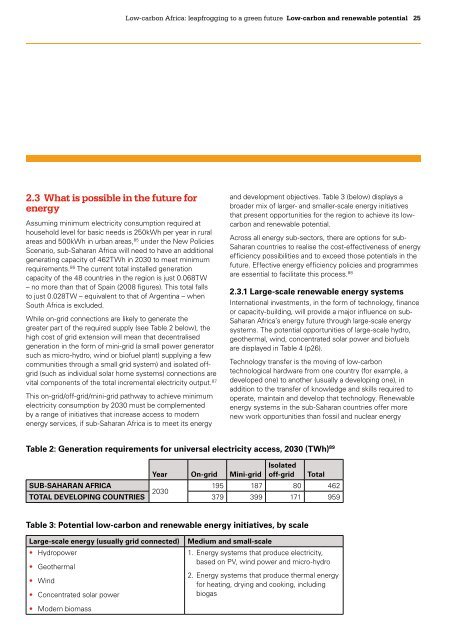Ju8uG
Ju8uG
Ju8uG
Create successful ePaper yourself
Turn your PDF publications into a flip-book with our unique Google optimized e-Paper software.
Low-carbon Africa: leapfrogging to a green future Low-carbon and renewable potential<br />
25<br />
2.3 What is possible in the future for<br />
energy<br />
Assuming minimum electricity consumption required at<br />
household level for basic needs is 250kWh per year in rural<br />
areas and 500kWh in urban areas, 85 under the New Policies<br />
Scenario, sub-Saharan Africa will need to have an additional<br />
generating capacity of 462TWh in 2030 to meet minimum<br />
requirements. 86 The current total installed generation<br />
capacity of the 48 countries in the region is just 0.068TW<br />
– no more than that of Spain (2008 figures). This total falls<br />
to just 0.028TW – equivalent to that of Argentina – when<br />
South Africa is excluded.<br />
While on-grid connections are likely to generate the<br />
greater part of the required supply (see Table 2 below), the<br />
high cost of grid extension will mean that decentralised<br />
generation in the form of mini-grid (a small power generator<br />
such as micro-hydro, wind or biofuel plant) supplying a few<br />
communities through a small grid system) and isolated offgrid<br />
(such as individual solar home systems) connections are<br />
vital components of the total incremental electricity output. 87<br />
This on-grid/off-grid/mini-grid pathway to achieve minimum<br />
electricity consumption by 2030 must be complemented<br />
by a range of initiatives that increase access to modern<br />
energy services, if sub-Saharan Africa is to meet its energy<br />
and development objectives. Table 3 (below) displays a<br />
broader mix of larger- and smaller-scale energy initiatives<br />
that present opportunities for the region to achieve its lowcarbon<br />
and renewable potential.<br />
Across all energy sub-sectors, there are options for sub-<br />
Saharan countries to realise the cost-effectiveness of energy<br />
efficiency possibilities and to exceed those potentials in the<br />
future. Effective energy efficiency policies and programmes<br />
are essential to facilitate this process. 88<br />
2.3.1 Large-scale renewable energy systems<br />
International investments, in the form of technology, finance<br />
or capacity-building, will provide a major influence on sub-<br />
Saharan Africa’s energy future through large-scale energy<br />
systems. The potential opportunities of large-scale hydro,<br />
geothermal, wind, concentrated solar power and biofuels<br />
are displayed in Table 4 (p26).<br />
Technology transfer is the moving of low-carbon<br />
technological hardware from one country (for example, a<br />
developed one) to another (usually a developing one), in<br />
addition to the transfer of knowledge and skills required to<br />
operate, maintain and develop that technology. Renewable<br />
energy systems in the sub-Saharan countries offer more<br />
new work opportunities than fossil and nuclear energy<br />
Table 2: Generation requirements for universal electricity access, 2030 (TWh) 89<br />
Year On-grid Mini-grid<br />
Isolated<br />
off-grid Total<br />
SUB-SAHARAN AFRICA<br />
195 187 80 462<br />
2030<br />
TOTAL DEVELOPING COUNTRIES 379 399 171 959<br />
Table 3: Potential low-carbon and renewable energy initiatives, by scale<br />
Large-scale energy (usually grid connected)<br />
• Hydropower<br />
• Geothermal<br />
• Wind<br />
• Concentrated solar power<br />
• Modern biomass<br />
Medium and small-scale<br />
1. Energy systems that produce electricity,<br />
based on PV, wind power and micro-hydro<br />
2. Energy systems that produce thermal energy<br />
for heating, drying and cooking, including<br />
biogas


